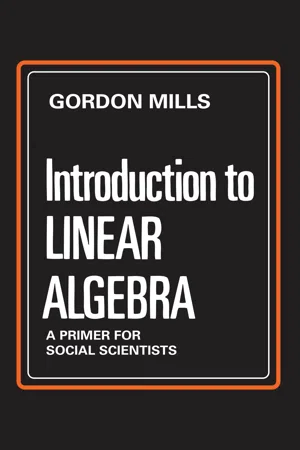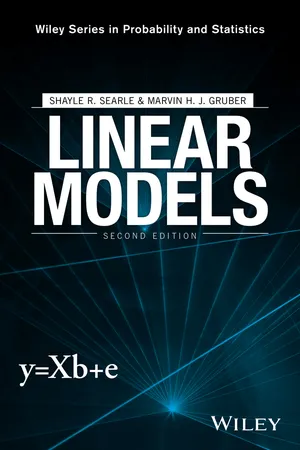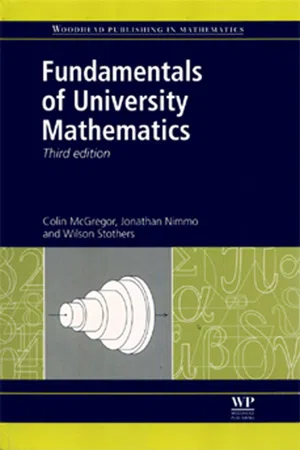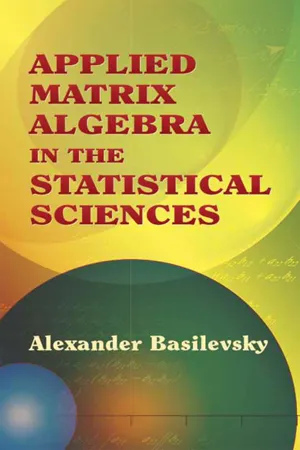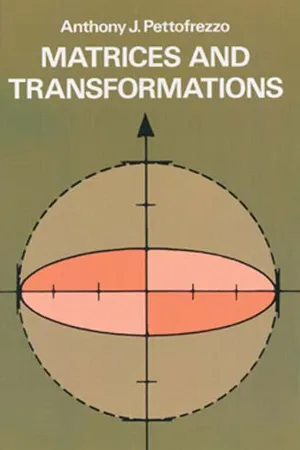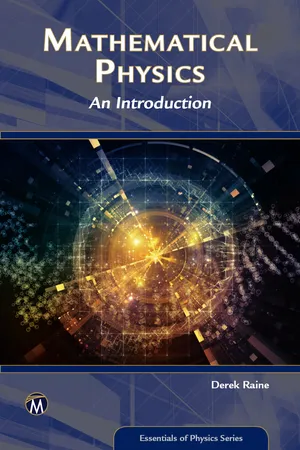Mathematics
Inverse Matrices
Inverse matrices are a fundamental concept in linear algebra. For a given square matrix, its inverse is another matrix that, when multiplied with the original matrix, yields the identity matrix. This concept is crucial for solving systems of linear equations and for various applications in fields such as physics, engineering, and computer graphics.
Written by Perlego with AI-assistance
Related key terms
Related key terms
1 of 4
Related key terms
1 of 3
11 Key excerpts on "Inverse Matrices"
- eBook - ePub
Introduction to Linear Algebra
A Primer for Social Scientists
- Gordon Mills(Author)
- 2017(Publication Date)
- Routledge(Publisher)
CHAPTER 5The inverse of a square matrix5.1 The concept of an inverse matrix
In Chapter 3 , matrix operations of addition, subtraction and multiplication were defined. In arithmetic and in scalar algebra, there is also an operation of division. Can a similar operation be defined for matrices ? The present chapter deals at some length with this question. The answer is that such an operation can be defined, but the parallel with the division of scalars is by no means exact. In fact the differences are so great that it is better to think in terms of comparing the matrix operation with the scalar operation of multiplying by a reciprocal. In arithmetic, instead of dividing by 2 we can speak of multiplying by (2)−1. . More generally, given a scalar λ≠ 0, we can speak of multiplying by λ −1 ; this operation has the propertyλλ = λ− 1λ= 1− 1For matrix algebra, this prompts the question: for a given matrix A can a matrix B be found such thatBA = AB = Iwhere I is an identity matrix of order n ? For these matrix equations to hold, B must have n rows and A must have n columns, so that BA is of order n × n. Similarly A must have n rows and B must have n columns if AB is to be of order n×n. In other words if we want to confine our attention to cases where BA and AB are of the same order, then A must be a square matrix, in which case B is also square. This leads to the following definition of an inverse matrix (which bears a rough analogy to the reciprocal of scalar algebra):Definition. Given a square matrix A , if there exists a square matrix, to be denoted A−1 , which satisfies the relationAA =− 1AA= I− 1then A−1 is called the inverse matrix (or simply the inverse) of A .Notice that the definition has to be qualified by the clause ‘if there exists a square matrix’. Nothing that has been said so far demonstrates that such a matrix will exist for a given (square) matrix A . Indeed we shall see later that in some circumstances no such matrix exists, i.e. that it is not possible to find a matrix A −1 - eBook - ePub
- Shayle R. Searle, Marvin H. J. Gruber(Authors)
- 2016(Publication Date)
- Wiley(Publisher)
1 GENERALIZED Inverse Matrices 1. Introduction Generalized Inverse Matrices are an importanusefult and mathematical tool for understanding certain aspects of the analysis procedures associated with linear models, especially the analysis of unbalanced data for non-full rank models. The analysis of unbalanced data and non-full rank models is of special importance and thus receives considerable attention in this book. Therefore, it is appropriate that we summarize the features of generalized inverses that are important to linear models. We will also discuss other useful and interesting results in matrix algebra. We will frequently need to solve systems of equations of the form Ax = y where A is an m × n matrix. When m = n and A is nonsingular, the solution takes the form x = A − 1 y. For a consistent system of equations where m may not equal n, or for square singular matrices, there exist matrices G where x = Gy. These matrices are generalized inverses. Example 1 Need for Generalized Inverses Consider the system of equations or in matrix format Notice that the coefficient matrix is not of full rank. Indeed, the second and third rows add up to the first row. Solutions of this system include and infinitely many others. Each of the 3 × 3 matrices in the above solutions is generalized inverses. a. Definition and Existence of a Generalized Inverse In this book, we define a generalized inverse of a matrix A as any matrix G that satisfies the equation (1) The reader may verify that the 3 × 3 matrices in the solutions to the system in Example 1 satisfies (1) and are thus, generalized inverses. The name “generalized inverse” for matrices G defined by (1) is unfortunately not universally accepted. Names such as “conditional inverse,” “pseudo inverse,” and “g-inverse” are also to be found in the literature. Sometimes, these names refer to matrices defined as is G in (1) and sometimes to matrices defined as variants of G - eBook - ePub
- Shayle R. Searle(Author)
- 2012(Publication Date)
- Wiley-Interscience(Publisher)
CHAPTER 1
GENERALIZED Inverse Matrices
1. INTRODUCTION
The application of generalized Inverse Matrices to linear statistical models is of relatively recent occurrence. As a mathematical tool such matrices aid in understanding certain aspects of the analysis procedures associated with linear models, especially the analysis of unbalanced data, a topic to which considerable attention is given in this book. An appropriate starting point is therefore a summary of the features of generalized Inverse Matrices that are important to linear models. Other ancillary results in matrix algebra are also discussed.a. Definition and existenceA generalized inverse of a matrix A is defined, in this book, as any matrix G that satisfies the equation(1)The name “generalized inverse” for matrices G defined by (1) is unfortunately not universally accepted, although it is used quite widely. Names such as “conditional inverse”, “pseudo inverse” and “g-inverse” are also to be found in the literature, sometimes for matrices defined as is G of (1) and sometimes for matrices defined as variants of G. However, throughout this book the name “generalized inverse” of A is used exclusively for any matrix G satisfying (1) .Notice that (1) does not define G as “the” generalized inverse of A but as “a” generalized inverse. This is because G, for a given matrix A, is not unique. As shown below, there is an infinite number of matrices G that satisfy (1) and so we refer to the whole class of them as generalized inverses of A.One way of illustrating the existence of G and its non-uniqueness starts with the equivalent diagonal form of A. If A has order p × q the reduction to this diagonal form can be written asor, more simply, asAs usual, P and Q are products of elementary operators [see, for example, Searle (1966), Sec. 5.7], r is the rank of A and Dris a diagonal matrix of order r. In general, if d1 d2 , …, dr, are the diagonal elements of any diagonal matrix D we will use the notation D{di} for Dr - EK Ummer(Author)
- 2012(Publication Date)
- Routledge(Publisher)
I as follows:Notice that the last augmented matrix is in reduced row echelon form. Therefore, as we stated above, the inverse of A is . Notice that this is exactly the same as the result we obtained when we used determinant and adjoint to find the inverse of A in the previous section.2.5.4 Properties of Inverse The inverse of a square matrix obeys some important properties. These properties are the following.
2.5.5 Solution of SSLEs Using InverseProperty I.If A is an invertible square matrix, then (A−1 )−1 = A.Property II.If s is a scalar not equal to zero and A is an invertible square matrix, then (sA)−1 = s−1 A−1 .Property III.If A is a square matrix, and if AT is invertible, then (AT )−1 = (A−1 )T .Property IV.If A and B are two square matrices of the same order, and if (AB)−1 exists, then (AB)−1 = B−1 A−1 .Property V.If A is a square matrix and I is an identity matrix of the same order as that of A, and if A is invertible, then AA−1 = I.In Section 2.4.5 we applied Cramer’s rule to solve two SSLEs. In this section we attempt to solve the same systems with the help of inverse – the last method of solution of SSLEs we consider in this book.Suppose, as in Section 2.4.5, we have an m × n (with m = n) SSLEs represented by the matrix equation Ax = d, where A represents the n × n coefficient matrix, x represents the n × 1 variable vector, and d represents the n × 1 constant vector. Let us now post-multiply A and pre-multiply d of the equation Ax = d by the inverse of A, A−1 . These yield AA−1 x = A−1 d. Since A A−1 = I, the last equation simplifies toEquation (2.5.2) is a very important result in linear algebra. It states that the solution of a SSLEs is given by the product of the inverse of the matrix of coefficients and the vector of the constants of the system. This is called the method of solving SSLEs using inverse- Stephen Garrett(Author)
- 2015(Publication Date)
- Academic Press(Publisher)
It is, therefore, seen that pre- and post-multiplication by 0 m leads to 0 m. The matrices A and 0 m therefore do commute, as one might intuitively expect. Furthermore, we can define the square matrix equivalent of unity. This is denoted by I m and consists of unit entries on the main diagonal and 0 elsewhere. For example, I 2 = 1 0 0 1 and I 5 = 1 0 0 0 0 0 1 0 0 0 0 0 1 0 0 0 0 0 1 0 0 0 0 0 1 It should be clear from Eq. (10.10) that I m commutes with any m × m matrix A and is such that A I m = I m A = A (10.17) A trivial property of both 0 m and I m is that they are symmetric, that is 0 m T = 0 m and I m T = I m. 10.3.2 Inverse Matrices We have so far defined matrix addition, subtraction, and multiplication, but we are yet to define an equivalent for the division of matrices. This is considered here. In terms of scalar arithmetic, it is clear that dividing by a non-zero number is equivalent to multiplying by the reciprocal of that number. For example, 7 2 ≡ 2 − 1 × 7 Indeed standard algebraic convention is such that multiplying by 2 −1 is universally understood as meaning “divide by 2.” Similarly, dividing by matrix A should be considered as equivalent to multiplying by A −1, where A −1 is referred to as the inverse of A. As we shall see, only square matrices can have an inverse but squareness alone is not sufficient to ensure that a matrix is invertible (i.e., has an inverse). For scalars, it is clear that k −1 × k = k × k −1 = 1 for k ≠0. Similarly, the inverse of square matrix A is such that A − 1 A = A A − 1 = I m (10.18) Indeed matrix A is said to be invertible if it is square and A −1 exists such that Eq. (10.18) is satisfied. This expression, therefore, acts as the definition of A −1. It should be immediately clear from Eq. (10.18) that I m − 1 is the inverse of I m, and 0 m is non-invertible. Example 10.11 Demonstrate that A = 1 2 1 2 1 2 − 1 2 has inverse A − 1 = 1 1 1 − 1. Solution To show that A −1 is the inverse of A, we need to confirm that Eq- eBook - ePub
- Michael Harrison, Patrick Waldron(Authors)
- 2011(Publication Date)
- Routledge(Publisher)
The trace of the identity matrix of order n is tr (I n) = ∑ i = 1 n 1 = n Property 1 We have tr(AB) = tr(BA), where A is an m × n matrix and B is an n × m matrix. The proof of this result constitutes a useful exercise in the manipulation of typical terms, but note that it will involve the use of double summation and hence may be a little tricky; see Exercise 1.14. 1.5.4 Inverse matrix If A, B and C are square matrices of the same order, say, n × n, and AC = I = BA, then C is called a right inverse of A and B is called a left. inverse of A. In fact, B = BI = B (AC) = (BA) C = IC = C, so the right inverse must equal the left inverse, and they can be called simply the inverse of A (and, vice versa, A is called the inverse of B). Matrices A and B are said to be invertible. Example 1.5.2 Let A = [ 1 2 2 3 ] and B = [ − 3 2 2 − 1 ] 1.47 Using the operation of matrix multiplication, we have. that A B = [ 1 2 2 3 ] [ − 3 2 2 − 1 ] = [ 1 0 0 1 ] = I 2 1.48 and B A = [ − 3 2 2 − 1 ] [ 1 2 2 3 ] = [ 1 0 0 1 ] = I 2 1.49 By definition, then, A and B are both invertible: A is the inverse of B, and B is the inverse of A. ⋄ Not all square matrices will have inverses associated with them, but we will leave the question of what property of any particular square matrix guarantees the existence of an. inverse until Chapter 2. The concept of the inverse of a matrix, which, when it exists, serves in matrix algebra much like the reciprocal of a number does in scalar algebra, is very important, and there are several useful properties relating to it. We will state the main properties of matrix inverses rather formally as theorems and consider their proofs; it is instructive to do so and provides useful illustrations of matrix manipulation using the matrix operations, the rules of matrix algebra and the identity matrix and its property presented above. The first property is established using a proof by contradiction - eBook - ePub
- Colin McGregor, Jonathan Nimmo, Wilson Stothers(Authors)
- 2010(Publication Date)
- Woodhead Publishing(Publisher)
Chapter 11Matrices and Linear Equations
In Chapter 1 , we mentioned the fact that a pair (x, y ) of real numbers can be used to represent a point in the plane. In Chapter 6 , we used such a pair to represent a complex number. This is an example of an important aspect of mathematics— a mathematical object may be interpreted in several different ways. Once we have studied the mathematical objects, we have information which is available in every interpretation.In this chapter we introduce a new mathematical object—the matrix. An m × n matrix is a rectangular array of mn numbers. We can think of the matrix as consisting of m rows , each having n entries , or as n columns , each having m entries. For example,is a 2 × 3 matrix. We regard a matrix as a single entity, to be manipulated as a whole.We define addition on the set of m × n matrices. This operation has properties similar to the addition of real numbers. In particular, there is azero matrix Om × nin the set which behaves like 0 in , i.e.Under certain circumstances, we can define multiplication of matrices. Now some of the results are unfamiliar. For example, there are matrices A and B for which AB ≠ BA.Matrices have many uses in mathematics and its applications. Here we consider just one—the solution of (systems of) linear equations. Looking at such a system leads to the introduction of new operations on matrices. We develop a systematic method for finding all the solutions.In the final sections, we return to the mathematical study of matrices. We consider the existence of matrix inverses. Along the way, we meet the concept of the determinant of a (square) matrix. This is an important topic in its own right and will be used in Chapter 13 in connection with the vector product.11.1 Basic Definitions
Definitions 11.1.1 Let be a number system. A matrix defined over is a rectangular array of elements of . These elements are the entries of the matrix. If a matrix A has m rows (horizontal lines of entries) and n columns (vertical lines), then A is of type m × n or is an m × n bmatrix. - Alexander Basilevsky(Author)
- 2013(Publication Date)
- Dover Publications(Publisher)
Chapter 6Generalized Matrix Inverses
6.1 Introduction
A recent development in matrix algebra now finding wide use in statistics is the so-called generalized inverse of a matrix. Since generalized inverses are of many types, and since the topic has grown out of diverse mathematical and statistical literature, there is as yet no agreed-upon terminology in use. Thus generalized inverses are also referred to as pseudo-inverses, effective inverses, conditional inverses, Moore-Penrose inverses, semi-inverses, Vagner inverses, or simply as g inverses, with possible subscripting of the letter g. The lack of a common terminology, however, need not impose undue difficulties, since similar practice also exists in other areas of matrix theory and statistics. Thus it was observed in Chapter 5, for example, that latent roots and vectors are referred to by a variety of names. Also, since generalized inverses are of many types, a particular term is at times associated with a particular form of generalized inverse. For the sake of consistency, however, and in keeping with current statistical practice, the term generalized inverse is employed throughout the chapter.It was observed in Chapter 3 that a n × k rectangular (singular) matrix A possesses either a left inverse or a right inverse when p(A ) = min(n , k ). When a matrix is not of full rank, neither a left nor a right inverse exists (Figure 6.1 ), and as a result we cannot always use a matrix inverse to solve equations, for example, even in the case of a consistent linear system that always possesses at least one solution. In order to extend the notion of a matrix inverse to more general systems of linear equations, we introduce a yet wider type of matrix inverse known as a generalized inverse. The notion of a generalized inverse can then be easily extended to inconsistent linear systems, which play a major role in statistical estimation. The relationship between the type of inverse and the nature of the solution(s) of nonhomogeneous linear equations is portrayed in Figure 6.1- eBook - ePub
- Anthony J. Pettofrezzo(Author)
- 2012(Publication Date)
- Dover Publications(Publisher)
−1 . Note carefully that the elementary row transformation matrices used must be multiplied in the reverse order of their application.Example 4 Determine the inverse of A whereSince A is nonsingular, perform the elementary row transformations on A until the identity matrix I is obtained. The product of the matrices representing the transformations will be equal to A −1 . For example, multiply the elements of row one by ( ) and add the products to the corresponding elements of row two:multiply the elements of row one by ( ), then multiply the elements of row two by ( ):multiply the elements of row two by ( ) and add the products to the corresponding elements of row one:Hence,Exercises
- 1. Show that the functions 2x + z , x + y , and 2y − z are linearly dependent.
- 2. Show that the functions x + y − z , 2x + y + 3z , and x + 2y + 4z are linearly independent.
In Exercises 3 through 5 determine the rank of the given matrix .- 3 .
- 4 .
- 5 .
- 6. Prove that the rank of any skew-symmetric matrix cannot be one.
- 7. Determine the maximum number of elementary row transformations necessary to transform a square matrix of order n to echelon form.
- 8. State the general forms of the elementary row transformation matrices of order two.
- 9.
- 10.
- 11.
- 12. Express the matrix given in Exercise 9 as a product of elementary row transformation matrices.
2-5 Systems of Linear Equations
Consider a system of m linear equations in n variables x 1 , x 2 , . . . , x n :(2-17)The system of (2-17) may be written in matrix form as(2-18)The matrix ((a ¡j )) of order m by n is called the matrix of coefficients. The matrix composed of the mn elements a ij plus an additional column whose elements are the constants c 1 is called the augmented matrix of the system; that is,(2-19)is the augmented matrix of (2-17). Note that the rank of the augmented matrix is either equal to or one greater than the rank of the matrix of coefficients. - eBook - ePub
Mathematical Physics
An Introduction
- Derek Raine(Author)
- 2018(Publication Date)
- Mercury Learning and Information(Publisher)
5MATRICES
You should be familiar with the solution of a pair of simultaneous linear equations in two unknowns, by the elimination of one variable. You might think that more equations in more unknowns could be solved by a similar process of successive eliminations. If all you ever want to do is to solve specific equations then this is correct (but not very efficient; imaging trying this for 100 equations in 100 unknowns typical of large engineering projects).However, if you want to understand, for example, the circumstances under which a system of equations has a solution (since not all of them do), and to apply important tools for analyzing them, you will need to be familiar with the matrix representation of such systems of equations. The theory leads to the use of matrices as representations of transformations (for example a rotation of coordinate axes) and the construction of the “eigenvectors” and “eigenvalues” that turn out to play a crucial role in almost all branches of physical science (wherever small oscillations are important, e.g. in quantum mechanics and in numerical data analysis). These topics (matrices, eigenvectors etc.) are sometimes gathered under the umbrella term linear algebra.Let’s begin with what matrices are and some motivation for their introduction. Suppose we want to solve the pair of simultaneous equations We start by (for example) multiplying the second equation by 2: Adding the equations and multiplying the first by 5 gives and subtraction givesfrom which we can read off x = 1 and y = 2. Notice, however, that the x and y are acting merely as placeholders: if we keep everything aligned we do not have to write out the x and y - eBook - ePub
- P.M. Cohn(Author)
- 2017(Publication Date)
- Chapman and Hall/CRC(Publisher)
block decomposition.A block decomposition is often helpful in carrying out the multiplication of matrices with many entries. For example, a 60 × 60 matrix has 3600 entries and each entry in the product of two such matrices is a sum of 60 terms. This may exceed the storage capacity of our computer, but if we partition our matrices as 3 × 3 blocks of square matrices of order 20, we reduce the problem to a series of multiplications of pairs of matrices with 400 entries each, where each entry in the product is a sum of 20 terms.Often we need to consider matrices in which after partitioning all the non-zero blocks are along the main diagonal. If A1 , …, Arare any matrices, not necessarily of the same size, then the matrixA =()A 10 0 ⋯ 00A 20 ⋯ 0⋯ ⋯0 0 ⋯ 0A ris called the diagonal sum (or also direct sum) of the A3.9 THE INVERSE OF A MATRIXiand is denoted by A1 ⊕ A2 ⊕ … ⊕Ar. Occasionally we also write diag(A1 , …, Ar); this notation is used mainly when the Aiare all 1 × 1 matrices, so that A is in fact a diagonal matrix.For real numbers there is a fourth operation besides addition, subtraction and multiplication, namely division. For matrices this is more problematic, because of the non-commutativity of multiplication: one would have to distinguish between A/B and B\A, say, but one can at least consider the inverse of a matrix. A square matrix A is said to be invertible if there exists a matrix B such thatA B=B A= I(3.16) Such a matrix B is called the inverse of A and is denoted by A–1 . It is unique, if it exists at all, for if we also had AC = CA = I, thenC =C I= C(=A B)(B =C A)I B= Bwhere we have used the associative law. This means that once we have found (by whatever means) a matrix B satisfying (3.16 ), this B must be the inverse of A
Index pages curate the most relevant extracts from our library of academic textbooks. They’ve been created using an in-house natural language model (NLM), each adding context and meaning to key research topics.
Explore more topic indexes
Explore more topic indexes
1 of 6
Explore more topic indexes
1 of 4
